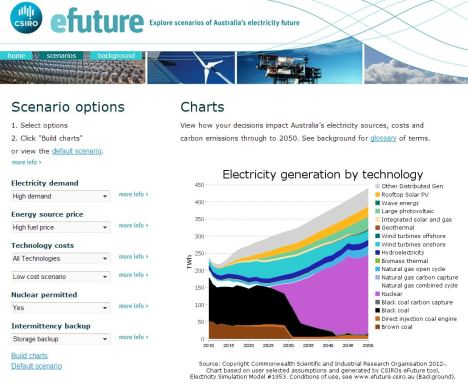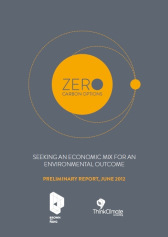 I’ve never asked the BNC community for any financial contribution. There’s no tip jar on the site; indeed I happily fund the website costs out of my pocket and give my time freely, because I think it’s a worthwhile pursuit. But now, I’d like to ask you to give a little, to a most worthy cause that encapsulates all that BraveNewClimate is about.
I’ve never asked the BNC community for any financial contribution. There’s no tip jar on the site; indeed I happily fund the website costs out of my pocket and give my time freely, because I think it’s a worthwhile pursuit. But now, I’d like to ask you to give a little, to a most worthy cause that encapsulates all that BraveNewClimate is about.
Ben Heard, my friend, colleague and fellow environmentalist traveller on the pro-nuclear, pro-full-decarbonisation road, has worked incredibly hard on a collaboration to do some serious clean energy planning. In this impressive 15,000 word report, Ben and his co-authors consider two alternate energy solutions, a hybrid solar/wind renewable solution and a reference nuclear solution, against the challenge of delivering the same hypothetical energy task: the replacement of the Northern and Playford Coal-Fired Power Stations in northern South Australia with clean energy. The report compares these solutions against 13 holistic sustainability and economic criteria. It’s a terrific case study, the lessons of which are applicable to decision makers far and wide.
As he says in his DSA post here, they wrote the report unpaid, because it matters. But if it’s going to have real-world impact, it needs effective publicity and wide distribution. This report must get into the hands of lots of people. That is where you can come in. Please consider giving a small donation to make it happen, even if it’s only a few $$. Every little bit helps.
Although the project has already received over half of the requested funds from 42 supporters, input has recently slowed to a trickle. As with most crowdsourced funding requests, the early donations are relatively easy to secure, whereas the ‘long tail’ is much tougher. It’s the old Pareto 80:20 principle.
To get a taste of what you would be supporting, you can read a preview of the introduction, here: Zero Carbon Options: Seeking an Economic Mix for an Environmental Outcome (4-page PDF). It’s well written and engaging, and, having twice refereed the whole report, I can confirm that it’s also extremely rigorous.
Below are some additional words from Ben, written especially for the BNC audience.
——————-
Zero Carbon Options – Launch the Report
 Ben Heard
Ben Heard
It’s not an original concept, either for the pages of BNC or anything else. We have all heard that the major hurdle nuclear power faces is social acceptance.
However after nearly two years of independent nuclear advocacy, I think I’m in a position to nuance that a little. The key word is “social”. Acceptance, per se, is not the issue.
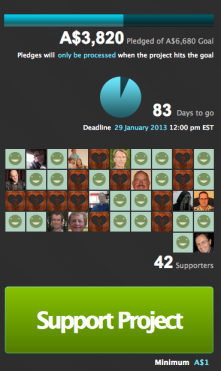 I have had a lot of conversations about nuclear power in the last two years. I have written a lot of articles, and given a lot of presentations. I have had many confidential meetings, taught many classes, and landed a pretty convincing debate victory. Along the way a few things have become very clear.
I have had a lot of conversations about nuclear power in the last two years. I have written a lot of articles, and given a lot of presentations. I have had many confidential meetings, taught many classes, and landed a pretty convincing debate victory. Along the way a few things have become very clear.
- Far, far more people are essentially supportive of the deployment of nuclear power in Australia than I originally believed. If this group is a minority of the population, it is not a small minority. However for the majority of these people the opinion is held quietly, mainly it seems from a sense of futility
- Many, many people want to know more about nuclear power. They want information. Whatever their view, it is not strongly held. Their opinions are in play. These people range in age, gender, political leaning and general walk of life but there are common reasons why they are seeking answers: concerns about climate change and a search for a solution that is up to the challenge
- A huge number of people in what I would describe as positions of power or influence in the political or business community, particularly in the energy community, are strongly supportive of nuclear power. But they see too much downside risk in either themselves or their organisation standing by that position
The “acceptance” of nuclear is everywhere. But except in rare and valuable forums like Brave New Climate, it has not been socialised. It has not been shared, voiced, and reinforced. It has not been widely stated, restated, and stood by because of a reinforcing silence and, frankly, fears of what other people think. Fear of how they will react. Nuclear suffers an appalling first mover syndrome for those who feel they have something at stake, whether it is friendships, votes, funding or customers.
That’s a deadlock we need to break. That’s why we wrote Zero Carbon Options.
When Brown & Pang approached me for a collaboration in nuclear, two things struck me. The first was the quality of their work. The second was that they did it. They did not wait for funding, or a buyer. They wrote a report Australia needed on nuclear workforce requirements because it needed to be done.
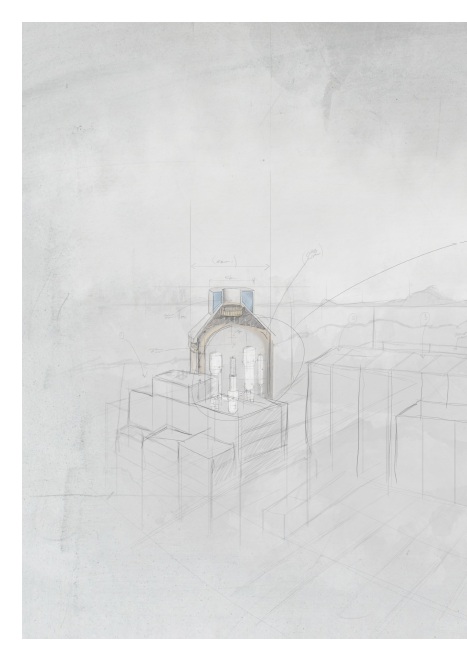 We agreed on something else that needed to be done. Something so simple it’s weird that it hadn’t been done before: a straight-up comparison of how two zero-carbon options would perform against an identical, precisely defined task: the replacement of actual coal-fired baseload in South Australia. Could there be a clearer, more tangible, more relevant way to demonstrate the essential role of nuclear power than such a comparison?
We agreed on something else that needed to be done. Something so simple it’s weird that it hadn’t been done before: a straight-up comparison of how two zero-carbon options would perform against an identical, precisely defined task: the replacement of actual coal-fired baseload in South Australia. Could there be a clearer, more tangible, more relevant way to demonstrate the essential role of nuclear power than such a comparison?
Six-months, 15,000 words, dozens of drafts and two rounds of expert review later, the report is finished. It is clear, easy to follow and well-structured. It is well researched and comprehensive. It will look outstanding, and it offers this unique comparison of options into the public conversation. As this article goes live it is in the safe hands of Brown & Pang for graphic design, and I am preparing to launch it. That, we hope, is where you come in.
Everything to date has been our work, freely given. We were happy to move and make this report happen. But launching a report in a meaningful way requires funds that independent consultants lack. We need your help to take a big step in socialising the acceptance of nuclear power. To that end we are accepting pledges for the launch of Zero Carbon Options via crowd-funding site Pozible.
The launch will be held in Adelaide on Wednesday 5 December. Based virtually on word of mouth (no media, no advertising) nearly 60 tickets have been snapped up for this in the week since it was announced. We are providing written invitations to every sitting member of the South Australian parliament, as well as a full range of Federal and local Government identities. We will be issuing media releases and invitations, and several media opportunities are already lining up. After I present the findings of the report, peer reviewers Professor Barry Brook and author and BNC regular Mr Martin Nicholson will be joined by myself and Professor Doug Boreham from Canada for a moderated question-and-answer session. Attendees will receive a hard copy of the report.
I know we can use this report to take a big step toward socialising the acceptance of nuclear power in Australia. But we can’t do it without you. Let’s get the nuclear discussion right into the mainstream in 2013. Please make a pledge and help us launch Zero Carbon Options.
Please visit our fundraising site and make a pledge by clicking on the image below.

———–
To register comments, go to the Brave New Climate Discussion Forum
Filed under: Emissions, Nuclear, Policy, Renewables, Scenarios | 1 Comment »
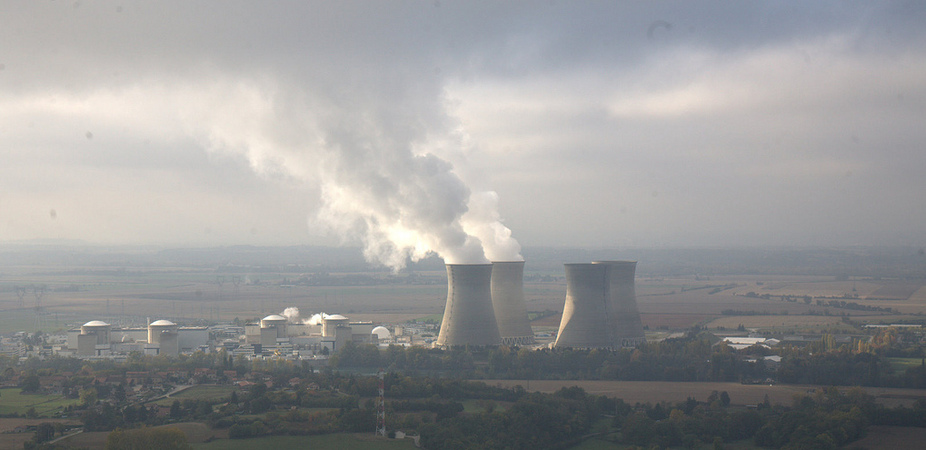 The Energy White Paper 2012 (EWP2012), released by the Australian Government last week, seeks to map out a strategic policy framework for future energy supply. One of the major goals of EWP2012 is to provide a “clear vision” of how Australia should set about the long-term task of decarbonising our stationary electricity, liquid fuels and industrial sectors. So how well does it succeed?
The Energy White Paper 2012 (EWP2012), released by the Australian Government last week, seeks to map out a strategic policy framework for future energy supply. One of the major goals of EWP2012 is to provide a “clear vision” of how Australia should set about the long-term task of decarbonising our stationary electricity, liquid fuels and industrial sectors. So how well does it succeed?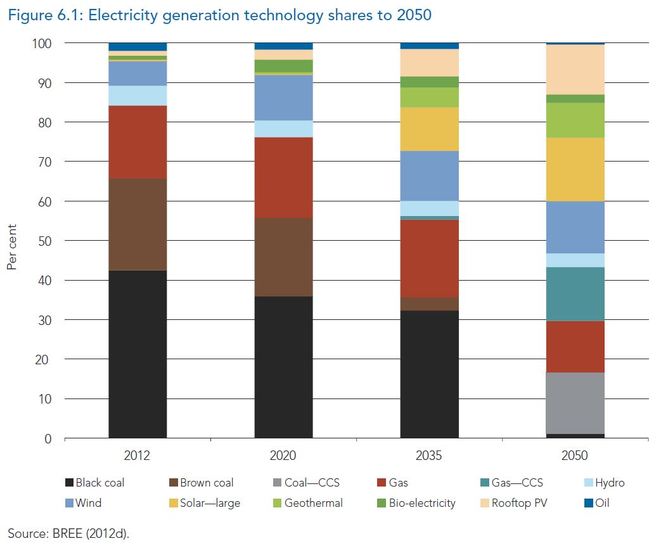 This shows a gradual phase out of traditional coal (to be replaced by carbon-capture and storage [CCS] variants after about 2035) and a ramp-up of combined cycle gas (both CCS and non-CCS). Up to half of electricity is coming from wind, solar thermal, solar PV and engineered geothermal by 2050. The estimated cost is “more than $200 billion in new generation investment”.
This shows a gradual phase out of traditional coal (to be replaced by carbon-capture and storage [CCS] variants after about 2035) and a ramp-up of combined cycle gas (both CCS and non-CCS). Up to half of electricity is coming from wind, solar thermal, solar PV and engineered geothermal by 2050. The estimated cost is “more than $200 billion in new generation investment”.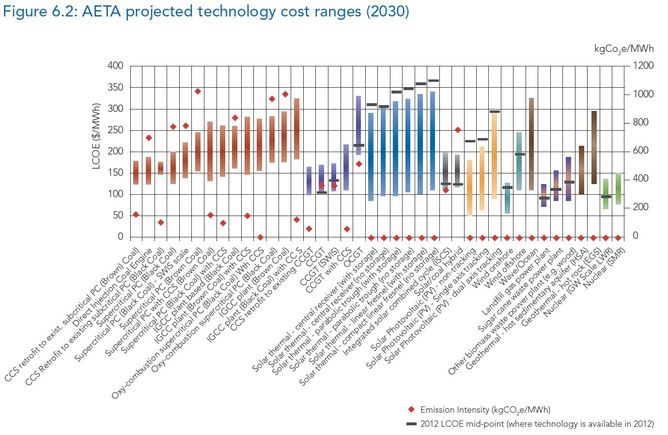 Nuclear power – generated by both large (“monolithic”) and small (“modular”) reactors – are an obvious low-cost, low-carbon (and baseload) standout here in Fig. 6.2. Yet nuclear power is invisible in the Fig. 6.1 projections.
Nuclear power – generated by both large (“monolithic”) and small (“modular”) reactors – are an obvious low-cost, low-carbon (and baseload) standout here in Fig. 6.2. Yet nuclear power is invisible in the Fig. 6.1 projections.





.png)
